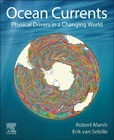
Ocean Currents of the World: Our Oceans in Motion
Marshall, Robert
Sebille, Erik van
Ocean Currents of the World: Our Oceans in Motion opens with a general introduction to ocean currents, covering basic principles of cause and effect, measurement and modelling, etc. The majority of the book comprises a sequence of chapters covering distinct aspects of contrasting ocean currents: broad and slow; deep and shallow; narrow and swift; large-scale and small-scale; low latitudes and high latitudes; moving in horizontal and vertical planes. Through this approach the authors cover a wide range of applications, from local to global, with considerable geographical context. Each chapter concludes with a suggested assignment and accompanying resource, helping to apply the information to a real-world context. Presents applications to natural phenomena, showing how ocean currents shape marine ecosystems, helping researchers understand the distribution and adaptation of life in the oceansAddresses societal challenges, specifically how ocean currents contribute to climate change impacts and disperse pollutants (e.g. plastic), helping researchers understand how ocean currents and are key to the fate of pollution from coastal sourcesIncludes end-of-chapter assignments, suggesting how students might apply their understanding of ocean currents, enabling instructors and students to progress beyond the material presented in each chapter INDICE: 1. Introduction to ocean currents - basic principles of cause and effect, measurement and modelling tools, etc.2. Global gyres/Ekman drift - slow background flows and evolution/plastics/volcanic pumice/tsunami debris3. Global western boundary currents and life - swift flows and marine life; dispersal of turtle hatchlings4. Global eastern boundary currents and life - European Slope Current; Californian, Humboldt and Benguela Currents; links to upwelling and shifting ecosystems5. Currents near the Equator and fast trans-basin flows - links to tropical climate variability (especially El Nino)6. Connecting Oceans with upper ocean flows - Agulhas and Tasman leakage (connecting Pacific, Indian and Atlantic Oceans)7. Polar currents, icebergs and sea ice - the Antarctic Coastal Current and the Labrador Current (conveying icebergs); the East Greenland Current (and sea ice)8. Connecting shallow (warm) and deep (cold) currents with climate - the Atlantic Meridional Overturning Circulation; the global Conveyor Belt circulation9. Seasonal flows in shallow shelf seas (around the world) and implications for pollution/biology10. Indigenous (ancient) knowledge of ocean currents - e.g., colonisation of Australia, Polynesia11. Utility of ocean currents for seafarers in recorded history - e.g., use of Gulf Stream for trans-Atlantic trade12. Research Challenges and the Future - How might new technologies help us to develop a more complete understanding of ocean currents? How might currents change with climate, how might they change climate?
- ISBN: 978-0-12-816059-6
- Editorial: Elsevier
- Encuadernacion: Rústica
- Páginas: 380
- Fecha Publicación: 01/11/2020
- Nº Volúmenes: 1
- Idioma: Inglés
